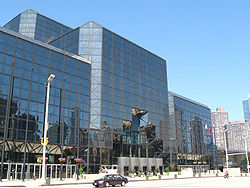Jacob K. Javits Convention Center
| Jacob K. Javits Convention Center | |
|---|---|

Front (east side) of the convention center
|
|
| Address | 655 West 34th Street |
| Location | Manhattan, New York 10014 |
| Coordinates | 40°45′26.64″N 74°0′9.12″W / 40.7574000°N 74.0025333°WCoordinates: 40°45′26.64″N 74°0′9.12″W / 40.7574000°N 74.0025333°W |
| Operator | New York City Convention Center Operating Corporation |
| Built | 1979-1986 |
| Inaugurated | 1986 |
| Opened | 1986 |
| Renovated | 2006-13 |
| Expanded | 2013 |
| Enclosed space | |
| • Total space | 1,800,000 sq ft (170,000 m2) |
| • Exhibit hall floor | 840,000 sq ft (78,000 m2) |
| • Breakout/meeting | 103,204 sq ft (9,588.0 m2) |
| Parking | Pay parking nearby |
| Public transit access |
New York City Subway: New York City Bus: M12, M34 SBS |
| Website | |
| www |
|
Jacob K. Javits Convention Center, shortened to Javits Center in popular usage, is a large convention center located on Eleventh Avenue, between 34th and 40th streets, in Hell's Kitchen, Manhattan, New York City. It was designed by architect James Ingo Freed of Pei Cobb Freed & Partners. The controversial and revolutionary space frame structure was begun in 1980, finished in 1986, and named for United States Senator Jacob K. Javits, who died that year. The Center is operated and maintained by the New York City Convention Center Operating Corporation. The convention center has a total area space of 1,800,000 square feet (170,000 m2) and has 840,000 square feet (78,000 m2) of total exhibit space.
When the Center opened, it replaced the New York Coliseum as the city's major convention facility, making way for the demolition of the Coliseum and future construction of the Time Warner Center at Columbus Circle. Today, it hosts events such as the New York International Auto Show and the New York Comic Con. It is billed as one of the busiest convention centers in the United States, but it is only the twelfth-largest.
Planning and constructing a convention center on Manhattan's west side has had a long and controversial history; proposals for a convention center to replace the New York Coliseum date to 1962, only six years after the Coliseum was completed. A new convention center over the river between 38th and 42nd Streets was included in the City's 1962 plan for the West Side waterfront. Several other sites were subsequently studied, including the New York Central rail yard between Tenth and Eleventh Avenues (now known as the Eastern Rail Yard site at the Hudson Yards) and the west 50s between Eighth and Ninth avenues. Eventually the Lindsay administration included a new convention center between 10th and 11th avenues in the west 40s along with an extensive redevelopment of the West Side in their 1969–70 Plan for New York City. Opposition to the massive residential displacement that this development project would have caused, and the failure of the City to complete any replacement housing, led the State Legislature to kill the convention center proposal in 1970. The City then moved the convention center site to the Hudson River, in place of Piers 84 and 86, despite the high cost of foundations and the lack of space for future expansion. That 44th Street convention center, designed by Gordon Bunshaft of Skidmore, Owings & Merrill, was approved by the Board of Estimate in 1973 despite renewed opposition from the local community. In exchange, the community received a special zoning district that offered some protection from development.
...
Wikipedia
